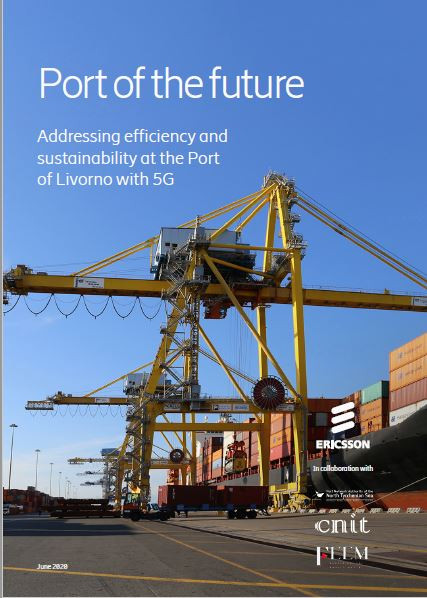Port of the Future – Addressing Efficiency and Sustainability at the Port of Livorno with 5G

19.06.2020
Laura Cavalli (Fondazione Eni Enrico Mattei); Giulia Lizzi (Fondazione Eni Enrico Mattei)
5G, Sustainability, Port, SDGs
2030 Agenda
Laura Cavalli
Adapting traditional business models to be more cost-effective, and socially and environmentally sustainable – the triple bottom line of sustainable development – is becoming increasingly important. This applies to all industries, diverse and multidimensional sectors and activities, of which ports are a key example. This can be achieved by implementing sustainable port growth policies, through new or re-designed operational planning. As part of this, introducing new technologies into port processes and ecosystems that factor in the environment, but have wider-reaching benefits, will enable a move towards the port of the future.
Although the expected consequences of a changed climate are one of the reasons behind actions in coastal protection and port management, issues such as scarcity of prime building locations, use of resources, environmental impact and the lives of neighboring communities also affect business decisions. 5G networks and digital technologies are crucial to addressing these challenges and transforming port operations to generate sustainable development.
Different methods can be used to measure the impact of technological advancements on competitiveness, efficiency and growth of the sector. In this report, however, we identify the UN Sustainable Development Goals (SDGs) and their corresponding measurable key port performance indicators that can be used to monitor sustainability performance and help make business decisions for port master plans.
Launched in 2015 as part of the 2030 Agenda for Sustainable Development, the 17 SDGs and their 169 associated targets represent an authoritative global guideline to achieving sustainability across different sectors. The agenda has many targets that can be directly or indirectly linked to port operations. These include the protection and management of ecosystems, as well as goals related to infrastructure and the circular economy, sustainable cities and communities, principles of good corporate governance, and data transmissibility and partnership relations management. With a timeline stretching to 2030, port authorities have time and capacity to contribute to the accomplishment of the 2030 Agenda for Sustainable Development.
Achieving the SDGs also requires public and private sector partnerships. In such a setup, port community actors are engines for change. They not only facilitate the reduction of emissions, to enable energy transition and stimulate the circular economy, but are also points of dialogue with urban stakeholders and port cities.
Adapting traditional business models to be more cost-effective, and socially and environmentally sustainable – the triple bottom line of sustainable development – is becoming increasingly important. This applies to all industries, diverse and multidimensional sectors and activities, of which ports are a key example. This can be achieved by implementing sustainable port growth policies, through new or re-designed operational planning. As part of this, introducing new technologies into port processes and ecosystems that factor in the environment, but have wider-reaching benefits, will enable a move towards the port of the future.
Although the expected consequences of a changed climate are one of the reasons behind actions in coastal protection and port management, issues such as scarcity of prime building locations, use of resources, environmental impact and the lives of neighboring communities also affect business decisions. 5G networks and digital technologies are crucial to addressing these challenges and transforming port operations to generate sustainable development.
Different methods can be used to measure the impact of technological advancements on competitiveness, efficiency and growth of the sector. In this report, however, we identify the UN Sustainable Development Goals (SDGs) and their corresponding measurable key port performance indicators that can be used to monitor sustainability performance and help make business decisions for port master plans.
Launched in 2015 as part of the 2030 Agenda for Sustainable Development, the 17 SDGs and their 169 associated targets represent an authoritative global guideline to achieving sustainability across different sectors. The agenda has many targets that can be directly or indirectly linked to port operations. These include the protection and management of ecosystems, as well as goals related to infrastructure and the circular economy, sustainable cities and communities, principles of good corporate governance, and data transmissibility and partnership relations management. With a timeline stretching to 2030, port authorities have time and capacity to contribute to the accomplishment of the 2030 Agenda for Sustainable Development.
Achieving the SDGs also requires public and private sector partnerships. In such a setup, port community actors are engines for change. They not only facilitate the reduction of emissions, to enable energy transition and stimulate the circular economy, but are also points of dialogue with urban stakeholders and port cities.
